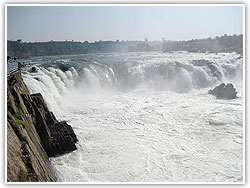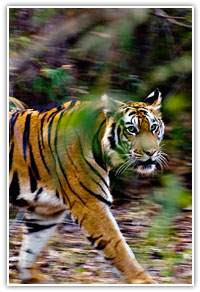|
|
Jabalpur, Madhya Pradesh
.............................................................................................................................................................................. |
|
Information about Jabalpur
Jabalpur is the city of marble rocks. Jabalpur was
once the capital and pleasure resort of the Gond
kings in 12th century AD. It was later the seat of
the Kalchuri dynasty until it fell to the
Marathas. The British took it in 1817 and left
their mark with the cantonment residences and
barracks. Today, Jabalpur is an important local
centre. Jabalpur is known all over the world for
the marble rocks and Dhuandhar Falls. During
summers, the temperature in Jabalpur ranges from
35 to 45 |
 |
|
|
Degree
Celsius and in winters, it ranges from 5 to 20 degree
Celsius. The best season to visit Jabalpur is from
October to March.
Tourist Attractions in Jabalpur
The main tourist attraction in Jabalpur are the
Dhuandhar Falls and Marble Rocks. The other attractions
are Hathi-Ka-Paon (Elephant’s Foot Rock), Monkey’s Leap
edge, Chausath Yogini Mandir, Madan Mahal Fort, Rani
Durgavati Memorial and Museum and Tilwara Ghat. There
are also Jain temples.
Dhuandhar Falls
Beraghat is the beautiful place, not far from Jabalpur.
At Beraghat, the Narmada flows through a 5 km. long
gorge. On its both sides are towering white marble
cliffs. Below the gorge, flows the Dhuandhar Falls. The
Dhuandhar Falls literally means the smoky falls.
Marble Rocks
The Marble Rocks are situated 24 km from Jabalpur at
Beraghat. These rocks rise to 30 m and stand on either
side of the 5 km. gorge through which the Narmada river
flows. These rocks produce a magical effect in
moonlight. It is an exciting and unforgettable
experience to row past the Marble Rocks on a full-moon
night. The silence of the night is broken by the soft
plop of the boatman’s oars. The waters of the river
reflect the moon at night. Recently the Marble Rocks
have been flood-lit by the Department of Tourism. Boats
are also available for boating. Cheap marble carvings
are also available at the site.
Chausath Yogini Mandir
Chausath Yogini Mandir is a 10th century temple with
stone carvings. According to the legend, it was
connected to the Gond queen Durgavati’s palace by an
underground passage.
Madan Mahal Fort
The Madan Mahal Fort was built by Madan Shah, the Gond
ruler.
Excursion
from Jabalpur |
|
|
|
Bandhavgarh
National Park
The Bandhavgarh National Park is situated about
170 km from Jabalpur. This park covers an area of
105 square km and situated in the Vindhya hills.
The main wild animals are tiger, leopard, sloth
bear, gaur, sambar, chital, muntjac, nilgai,
chinkara and wild pigs. Bandhavgarh is also known
as the place where the white (albino) tiger
originated. The tigers at Bandhavgarh have normal
coloured coasts. There are also many woodland
birds. There are also interesting cave shrines
scattered around the park as well as
archaeological remains of a fort believed to be
2,000 years old.
More....
Mandla
Mandla is situated about 97 km from Jabalpur in
the south-east along the Narmada valley. Mandla
was the |
 |
|
|
capital
of the ancient Gond Kingdom of Garha-Mandla early in the
Christian era. Later, the Gond Queen Rani Durgavati took
her life when her army was cornered by the forces of the
Mughal Viceroy Asaf Khan in 1564. The Marathas took it
and when Mandla was transferred to the British. In 1818,
the Maratha garrison refused to surrender. General
Marshall stormed it in March 1818. The fort has been
since taken over by the jungles. The fort was built in
the late 17th century and is surrounded on three sides
by the Narmada River. There are various temples and
ghats in the town.
How to reach Jabalpur
By Air:
Gwalior is connected by Indian Airlines flights with
Delhi, Mumbai, Bhopal, Indore. The airport is situated
about 12 km from the city centre.
By Rail:
Gwalior is situated on the Central Railway line between
Delhi, Mumbai and the Chennai-Delhi. It is directly
connected by rail with Delhi, Amritsar, Mumbai,
Bangalore, Bhopal, Jhansi and Agra.
By Road:
Gwalior is accessible on the NH3 (Agra-Mumbai) and on
the State Highway from Jhansi. It is connected by road
to Shivpuri, Indore, Ujjain, Agra, Jabalpur, Jhansi and
Khajuraho. |
|